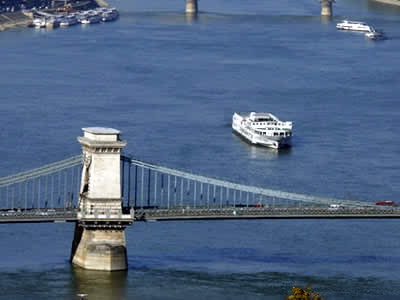Chain Bridge (Széchenyi lánchíd) was the first permanent bridge across the Danube in Budapest built owing to Count István Széchenyi, the very remarkable figure in Hungarian history.

This symbol of Budapest reproduced on many souvenirs and postcards, opened in 1849, though it was year 1820 when Count István Széchenyi vowed to himself that he would have the bridge built. This vow he made when he received the news that his father died in Vienna. It was cold December, and pontoon bridge across the Danube was put out of use by ice-floes. Széchenyi got stuck in the Pest riverbank for a few days before he could dash to Vienna.
The bridge was designed by the English engineer William Tierney Clark, and it was a larger scale version of Marlow Bridge across the River Thames in Marlow, England that the engineer built earlier.
Among the many anecdotes and myths connected to the bridge, the most popular is the one about the sculptor who created the lions without tongues. The legend says that he was mocked so much that he jumped into the Danube in shame. However, there is no evidence to prove whether this story is true.

During the World War II, the bridge was severely damaged and restored completely in 1949. The original parts of bridge from its reconstructions are kept today in the Transport Museum in Budapest.

A view of destroyed Chain Bridge in 1945.
Photo: Zoltan Seider
Source: Museum of Hungarian Architecture
In 2001, Hungarian stunt pilot Péter Besenyei flew upside down under the bridge, and since then this maneuver is a standard in Red Bull air races.
The Chain Bridge leads to Roosevelt Square on the Pest side of the Danube with the statue of Count István Széchenyi in its center and the ancient acacia tree believed to the oldest tree in Budapest.

On the Buda side the Chain Bridge ends with the Clark Adam Square named after the Scottish engineer who helped to build the bridge and the tunnel under the Castle Hill. Hungarian kids are told that the Chain Bridge is rolled in this tunnel in rainy days to keep it dry.